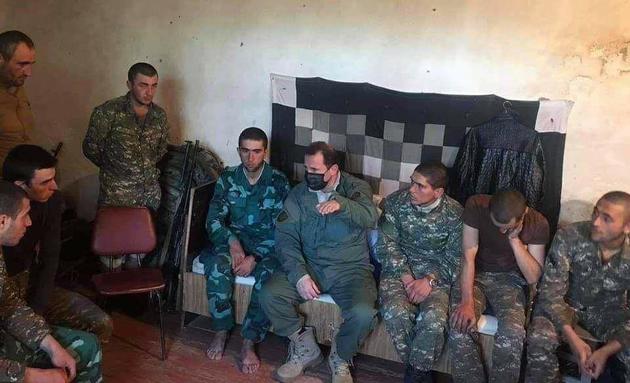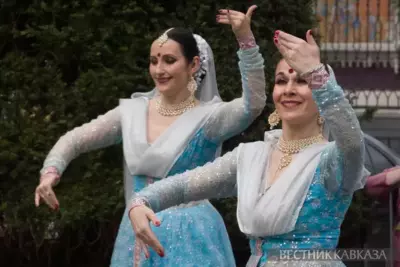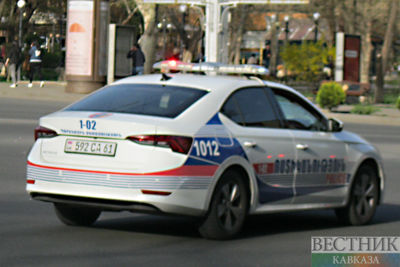As Vestnik Kavkaza previously reported, this week, the Armenian Defense Ministry published a photo of Defense Minister David Tonoyan’s meeting with Armenian soldiers, one of whom was in the military uniform of an Azerbaijani border guard. Thus, it became clear how fakes about mercenaries' participation in hostilities on the side of Azerbaijan are being produced in Armenia: Armenian soldiers dressed in Azerbaijani uniforms portray such mercenaries, and then the Armenian Ministry of Defense presents such photos and videos as "evidence".
Caspian News in the article Armenian Soldiers Camouflage in Azerbaijani Military Uniforms writes that commenting on the photo on his official Twitter account, Hikmet Hajiyev, Assistant of the Azerbaijani president and Head of Foreign Policy Affairs Department of the Presidential Administration, voiced his concerns over Armenia's making deliberate provocations.
"The Armenian side may also dress PKK terrorists and Armenian soldiers in military uniforms of the Azerbaijani Army, organize perpetration of military crimes against the civilian Armenian population, and attempting to put the responsibility on Azerbaijan," Hajiyev tweeted on Monday.
Previously, Armenia made false claims of Syrian mercenaries being deployed to support Azerbaijani forces in the fight against the Armenian troops amidst the fierce fighting between the two South Caucasus countries over the Nagorno-Karabakh region, an internationally recognized territory of Azerbaijan that remains occupied by Armenia. The Armenian side has repeatedly stated that Syrian mercenaries allegedly fought together with the soldiers from the Azerbaijani armed forces wearing the uniforms of Azerbaijani border guards.
"We wish to remind that most recently, Armenia had released an utterly unprofessional fake video regarding foreign mercenaries in uniforms of the State Border Service of the Republic of Azerbaijan, alleging that mercenaries were fighting on Azerbaijan's side," Hajiyev added.
Meanwhile, Armenia is intensively transferring PKK terrorists to Shusha, an ancient city of Azerbaijan that was occupied by Armenia in 1992. According to international media citing intelligence sources, PKK terrorists wore military uniforms of Azerbaijani armed forces. Speaking on condition of anonymity, the sources said that when the terrorists were killed, the Armenians would claim that they were mercenaries brought from Syria by the Azerbaijani army.
"We recall very well the fact that in 1988. Armenia's intelligence agencies, aided by the USSR's Committee of State Security, through an Armenian criminal Eduard Grigoryan, had organized pogroms of the civilian Armenian population in Sumgait and later blamed Azerbaijan for that," said Hajiyev in his statement.
The PKK is listed as an armed terrorist organization by Turkey, the United States, the European Union, Australia, Japan, and Azerbaijan. Since 1984, the PKK terrorist organization has been involved in an armed conflict with Turkey in an attempt to carve out an independent Kurdish state, later changing its demand to Kurdish autonomy in Turkey. As a result of its bloody actions and terror tactics, tens of thousands of military and civilian, including women, children and infants, were killed over the past decades.
Earlier, Armenian soldier Albert Mikaelyan, who was taken as prisoner by the Azerbaijani army, also admitted that the terrorists were fighting in the Armenian army ranks in the Nagorno-Karabakh region and said they are paid a monthly salary of $600.
"A barefoot Armenian soldier sitting next to the minister, wearing a military uniform identical to the one used by the State Border Service of the Republic of Azerbaijan, has raised serious suspicions," Hajiyev wrote, adding that several minutes after publishing Armenia's Defense Ministry's press service deleted those photos from the official accounts.
Tensions between Armenia and Azerbaijan escalated on September 27 when Armenian armed forces deployed in the occupied Azerbaijani lands made military provocations against Azerbaijani civilian settlements and military positions along the Line of Contact. The ongoing clashes mark the most intense fighting between Armenian and Azerbaijani forces since 1994 when a ceasefire was reached. Armenia's offensive prompted immediate counter-attack measures by Azerbaijani forces.
















